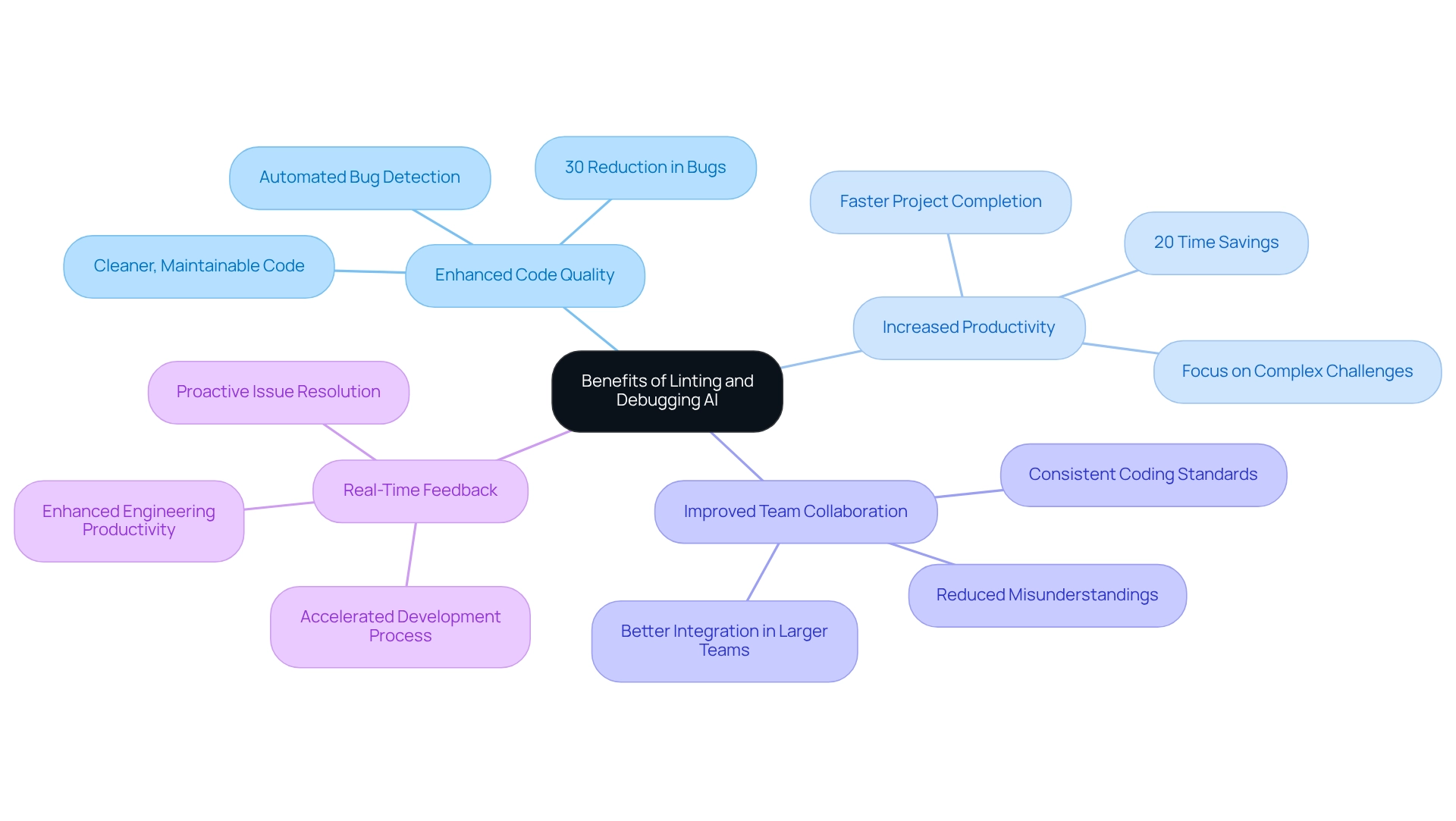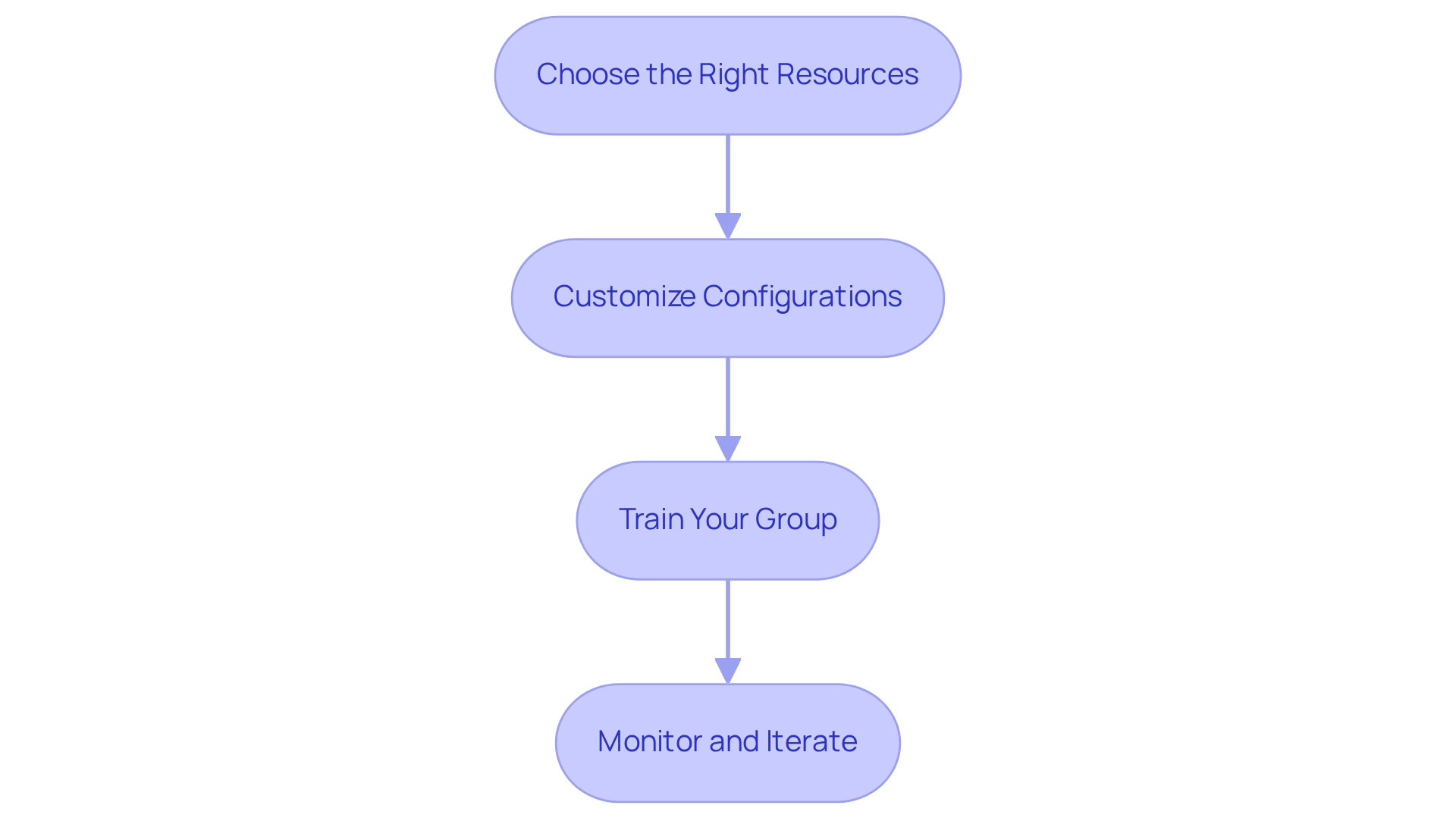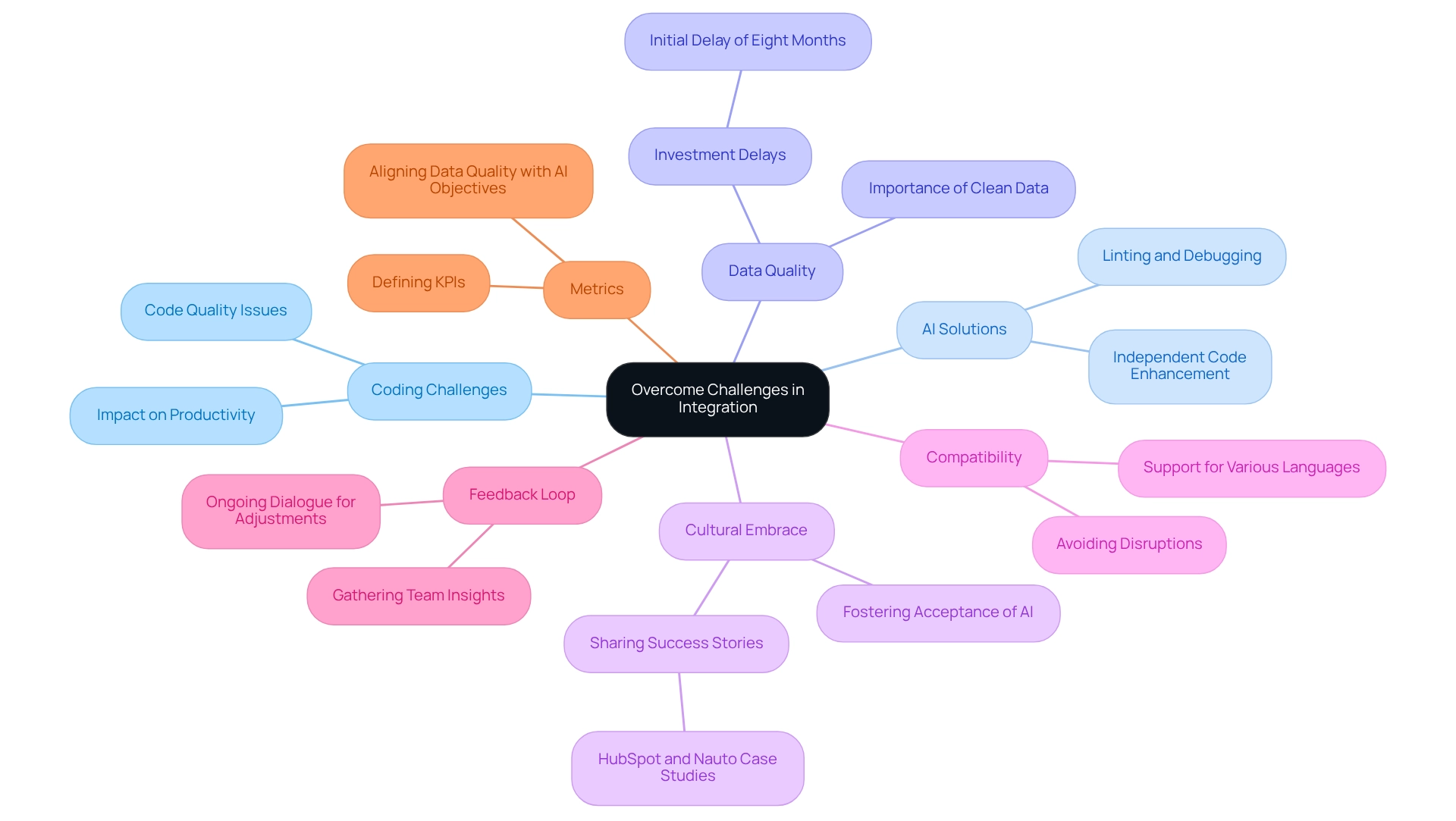Overview
The article begins by addressing the significant coding challenges developers encounter in their workflows. These challenges can hinder productivity and complicate the debugging process. How can developers overcome these obstacles? This is where Kodezi comes into play, offering innovative solutions tailored to enhance the coding experience.
Kodezi integrates four key strategies for effectively incorporating linting and debugging AI tools into software development workflows:
- It emphasizes the selection of appropriate resources, ensuring developers have the right tools at their disposal.
- Customizing configurations allows teams to tailor their environments to meet specific needs, thereby optimizing their workflows.
- Kodezi focuses on training teams, equipping them with the skills necessary to leverage these tools effectively.
- Continuous monitoring of performance is also a vital aspect, as it helps in enhancing code quality and streamlining debugging processes.
By implementing these strategies, Kodezi not only improves code quality but also significantly boosts developer productivity.
Ultimately, the benefits of using Kodezi are clear: improved productivity and enhanced code quality lead to a more efficient development process. Are you ready to explore the tools available on the Kodezi platform and transform your coding practices?
Introduction
In the ever-evolving landscape of software development, developers often face significant challenges, particularly in maintaining code quality and resolving errors. How can they effectively navigate these complexities? Enter Kodezi, an AI-powered tool that is transforming the approach to linting and debugging. By automating tedious tasks and providing real-time feedback, Kodezi enables developers to enhance their productivity and focus on more intricate coding challenges.
Imagine a scenario where code quality is maintained effortlessly, and errors are resolved swiftly. Kodezi makes this a reality, allowing teams to streamline their workflows. The benefits are clear:
- Improved efficiency
- Reduced frustration
- Ultimately, cleaner code
As the industry embraces these advancements, understanding the nuances of AI-driven tools becomes essential for developers eager to harness their full potential.
Are you ready to elevate your coding practices? Explore the innovative features Kodezi offers and discover how it can pave the way for a new era of software development. With Kodezi, the path to more maintainable code is clearer than ever.
Understand Linting and Debugging AI in Development
Coding can be fraught with challenges, from potential errors to stylistic inconsistencies and adherence to coding standards. Linting, the automated process of examining source material, plays a crucial role in addressing these issues. In 2025, advancements in linting and debugging AI tools have revolutionized traditional methods by employing machine learning algorithms to detect complex programming patterns and suggest meaningful improvements, while debugging focuses on identifying and correcting mistakes within a program. With AI, this process is significantly streamlined. By automating repetitive tasks, analyzing error logs, and providing context-aware recommendations, developers can enhance their productivity.
Kodezi exemplifies this transformation with its automated debugging feature, allowing developers to quickly identify and rectify issues in their codebase. Moreover, it offers detailed explanations of what went wrong and how to resolve it; this integration of linting and debugging AI not only accelerates debugging but also enhances overall program quality and maintainability. By addressing performance bottlenecks, identifying security vulnerabilities, and ensuring compliance with programming standards, Kodezi empowers developers to produce better code. As developers increasingly recognize the transformative potential of AI, understanding these concepts becomes essential for effectively leveraging AI resources in their workflows.
Are you ready to explore the tools Kodezi offers to elevate your coding practices?

Leverage the Benefits of Linting and Debugging AI
In the ever-evolving landscape of software development, developers frequently encounter significant coding challenges. How can these be effectively addressed? Incorporating AI-driven linting and debugging AI tools like Kodezi offers substantial advantages that can revolutionize development methods, and Kodezi excels at enhancing the quality of source code. The automated debugging tools are adept at detecting mistakes and upholding programming standards, resulting in cleaner, more maintainable code. Users have reported that the tool has assisted them in identifying and resolving bugs more quickly and effortlessly than manual methods, with some describing it as a lifesaver for correcting issues. Studies indicate that organizations utilizing AI for code quality improvements have seen notable enhancements in their codebases, with some reporting up to a 30% reduction in bugs. Yet, at present, merely 5% of programmers utilize AI in programming, emphasizing a significant opportunity for advancement in this field.
Furthermore, Kodezi enhances productivity by automating monotonous tasks. This allows developers to shift their focus to more intricate challenges, significantly decreasing overall development duration. Reports indicate that developers who use linting and debugging AI resources save an average of 20% of their time, enabling quicker project completion. As Kodezi's tools evolve, they are anticipated to drive even greater productivity improvements, delivering substantial business value in enterprise software development.
In addition, consistent coding standards foster enhanced collaboration among team members. Following the same guidelines reduces misunderstandings and integration challenges, which is essential in larger groups where multiple developers contribute to the same codebase. Kodezi's features ensure that programming quality is upheld consistently, improving group dynamics.
Moreover, the tool provides real-time feedback during the coding process. This allows developers to resolve issues as they occur instead of during subsequent testing stages. This proactive approach not only enhances software quality but also accelerates the development process, enabling teams to iterate more quickly. Users have pointed out that the platform has significantly enhanced engineering productivity, allowing teams to concentrate on more advanced tasks.
As artificial intelligence resources continue to evolve, their influence on code quality and maintainability is anticipated to increase. This evolution will result in enhanced productivity gains and provide significant business value in enterprise software development. Are you ready to explore the tools available on the Kodezi platform?

Implement Best Practices for Integration
To effectively incorporate linting and debugging AI into your development workflow, consider the following best practices:
- Choose the Right Resources:
Developers often face significant coding challenges. Selecting applications for linting and debugging AI that align with your project's specific requirements and programming languages is crucial. Kodezi CLI autonomously enhances your codebase and resolves issues before they reach production, making it a versatile option for B2B engineering groups. As the market for AI resources aiding software development swiftly grows, ensuring compatibility with your tech stack is vital. By 2025, two-thirds of enterprises will use AI internally for automation tasks, highlighting the importance of making informed choices. - Customize Configurations:
How can you ensure your team's coding standards are met? Adjusting the settings of your linting and debugging AI resources to align with your group's practices not only enhances programming quality but also encourages adherence to best practices, ensuring that your codebase remains tidy and compliant over time. Kodezi's AI-supported development tool can assist in enhancing and structuring your programming automatically, further aiding your group's efforts by incorporating linting and debugging AI checks into your continuous integration and deployment processes. This proactive approach allows teams to catch issues early, significantly reducing the risk of bugs and vulnerabilities in production. Remember, AI-generated code may contain bugs and security vulnerabilities, which is why linting and debugging AI are necessary for developers to maintain software stability. Kodezi's capabilities in automatic bug analysis and correction can be a valuable asset in this process. - Train Your Group:
Are your team members familiar with the resources and their functionalities? Offering extensive training sessions for your group is crucial, as statistics show that well-trained teams are more successful in adopting AI solutions, resulting in enhanced productivity and innovation. This aligns with the idea of a symbiotic relationship between AI and human developers, where each contributes their unique strengths. The platform's user-friendly interface and documentation can facilitate this learning process. - Monitor and Iterate:
How often do you assess the effectiveness of your resources? Regularly evaluating and making adjustments to enhance performance is key, as the future of software development will increasingly rely on a symbiotic relationship between AI and human developers, leveraging the strengths of both to enhance overall productivity. Kodezi exemplifies this by acting as an AI-powered programming resource that ensures your codebase remains robust and efficient.

Overcome Challenges in Integration
Coding challenges can often hinder developers' productivity and code quality. Integrating linting and debugging AI solutions, such as those provided by Kodezi, effectively addresses these challenges. By prioritizing clean, representative data for training AI models, Kodezi ensures high-quality outcomes. Poor data can lead to inaccuracies, potentially delaying AI implementation by up to eight months due to necessary investments in data quality.
Furthermore, fostering a culture that embraces new technologies is crucial. Kodezi demonstrates the benefits of AI solutions, such as CLI, which utilizes linting and debugging AI to independently enhance codebases and correct errors before they reach production. Sharing success stories from organizations that have successfully leveraged high-quality data integration can alleviate concerns and highlight tangible benefits. As Lev Craig points out, training models on biased data can result in distorted outcomes, emphasizing the need for varied data.
In addition, ensuring compatibility with current development environments is essential. Kodezi's system supports various programming languages and is designed to enhance efficiency, making it vital to avoid disruptions during the transition to AI-enhanced methods.
Establishing a continuous feedback loop is another key aspect. Gathering insights from team members about the performance of AI resources fosters ongoing dialogue, allowing for adjustments that ensure tools like Kodezi evolve to meet the team's needs effectively. Defining specific metrics and KPIs to align data quality efforts with AI objectives can help measure success and guide future improvements.
Are you ready to enhance your coding practices? Explore the tools available on the Kodezi platform to unlock improved productivity and code quality.

Conclusion
The integration of AI-powered linting and debugging tools, such as Kodezi, represents a pivotal transformation in software development practices. Developers often face significant coding challenges, including error detection and time-consuming debugging processes. By automating these tasks and providing real-time feedback, Kodezi not only enhances code quality but also boosts efficiency and fosters improved collaboration among teams. Consequently, developers can devote their attention to more complex challenges, resulting in faster project completions and cleaner codebases.
As the industry evolves, understanding how to leverage AI tools effectively becomes essential. Best practices, such as customizing configurations and incorporating these tools into CI/CD pipelines, are crucial for maximizing benefits. While challenges like data quality and resistance to change may surface, strategic approaches can help mitigate these issues, ensuring a smoother transition to AI-enhanced development processes.
In conclusion, embracing AI-driven solutions like Kodezi is no longer merely an option—it is a necessity for developers striving to remain competitive in a rapidly changing landscape. By prioritizing code quality and streamlining workflows, teams can achieve heightened productivity and deliver robust software solutions. The future of software development is here, and with tools like Kodezi, the path toward excellence in coding has never been clearer.
Frequently Asked Questions
What is linting in coding?
Linting is the automated process of examining source code to identify potential errors, stylistic inconsistencies, and adherence to coding standards.
How have advancements in AI impacted linting and debugging?
In 2025, advancements in linting and debugging AI tools have revolutionized traditional methods by using machine learning algorithms to detect complex programming patterns and suggest meaningful improvements, while also streamlining the debugging process.
What is the primary focus of debugging?
Debugging focuses on identifying and correcting mistakes within a program.
How does AI enhance the debugging process?
AI enhances debugging by automating repetitive tasks, analyzing error logs, and providing context-aware recommendations, which helps developers improve their productivity.
What is Kodezi and how does it contribute to coding practices?
Kodezi is a tool that exemplifies the transformation in debugging with its automated feature, allowing developers to quickly identify and rectify issues in their codebase, while also providing detailed explanations of errors and resolutions.
What benefits does Kodezi offer to developers?
Kodezi helps developers by accelerating debugging, enhancing overall program quality and maintainability, addressing performance bottlenecks, identifying security vulnerabilities, and ensuring compliance with programming standards.
Why is it important for developers to understand linting and debugging AI?
Understanding linting and debugging AI is essential for developers to effectively leverage AI resources in their workflows and enhance their coding practices.




